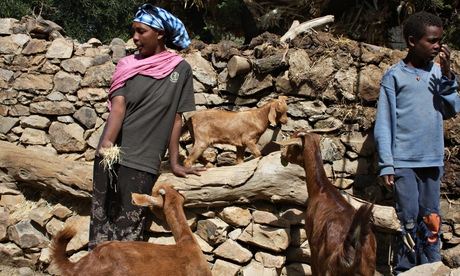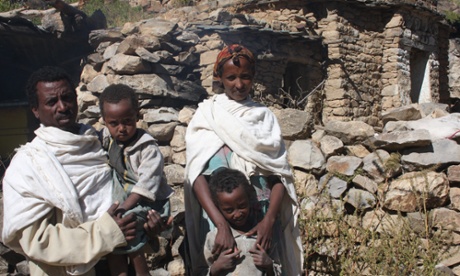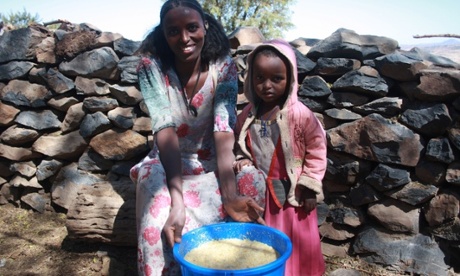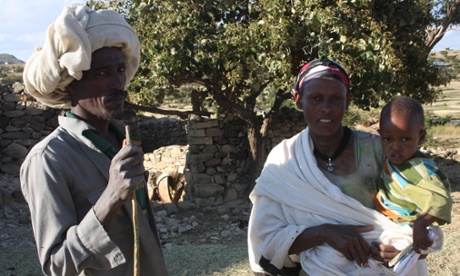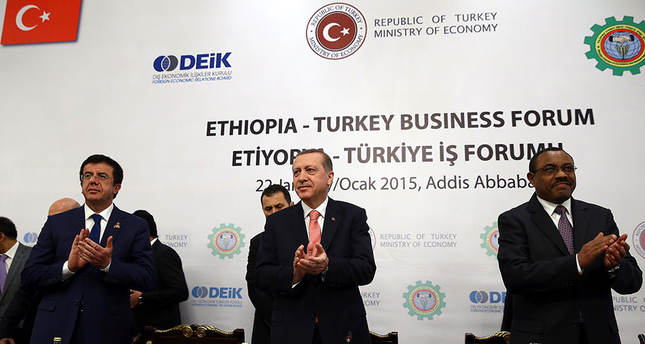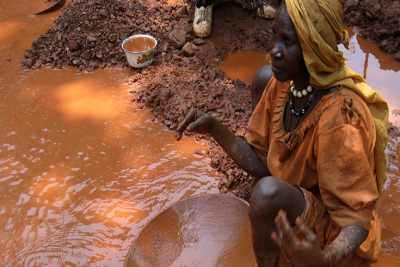.
Voucher to Replace Cash Credit for Farmers
.
Voucher, a system tested in a pliot project since 2012, is replacing cash-credit to farmers in some woredas
.
.
The government is replacing cash credit to farmers in some woredas with vouchers for them to access fertiliser and improved seeds.
This system was tested in a pilot project, which began in 2012 in the Amhara Regional State, in Baso Liben, Gozamin, Debere Elias, South Achefer and Metecha woredas. It lead to the expected implementation within the coming three months in 73 woredas, half the woredas in the region, involving 2.2 million farming households. The intention is to improve smallholder farmers’ access to credit for agricultural inputs including fertilisers and improved seeds.
Formerly, the Commercial Bank of Ethiopia (CBE) provided the fund to the bureaus of finance and economic development, which passed the money to unions. The unions passed it to cooperatives, which in turn gave loans to farmers with a full guarantee provided by the bureaus of agriculture. The problem was that the cooperatives distributed the money without any measures to make sure that the farmers would pay it back, says Teshome Walle (PhD), head of Amhara Regional Bureau of Agriculture. This lead to defaults of 143 million Br, 471 million Br, and 447 million Br, in the three years from 2011/12, in Amhara region alone. The defaulted amount was “recovered” by cutting the budgets to the woredas, according to the amount of default within each jurisdiction.
Now the Amhara Credit and Savings Association (ACSI) will issue vouchers to the Micro Finance Institutions (MFIs) under it. Farmers will only be able to get these vouchers – not cash-in order to get the inputs they need from cooperatives. The agriculture bureau will no longer provide guarantee, as that has now been replaced with a credit fund established at the ACSI. The farmers, too, will no longer have to start paying immediately, but get a grace period of a year, so that they can repay from the sale of their produce.
The MFI’s will issue the vouchers based on an assessment of the farmers seeking the loan, said Mekonen Yelewumwosen, CEO of ACSI. In 2013/14, the pilot woredas benefited from a credit supply of 196,000qt of fertilisers and seeds, worth 230 million Br, provided to them through the Agricultural Inputs Supply Corporation (AISCO), which is under the Minister of Agriculture(MTA). From total inputs distributed, 48pc was Urea, 42pc DAP, six percent NPS and three percent improved seeds, including teff, wheat, sorgum and maize.
Farmers in the pilot project paid back 99pc of the credit they had taken, said Mekonnen.
The existing practice gave cooperatives and unions five Br to 12 Br commission for every quintal of fertiliser. That has now been increased to 20Br in order to encourage them, said Tekeba Tebabal, deputy head of Amhara Corporative Promotion Agency.
The full project, to now be launched in the 73 woredas expects to extend loans amounting to 2.4 billion Br. ACSI will hire 4,280 workers to implement the project.
This project is supported by financial contributions from the Netherlands Embassy and Department of Foreign Affairs, Trade & Development Canada.
http://addisfortune.net/articles/voucher-to-replace-cash-credit-for-farmers/
.
Oil price decline lightens import bill
Image may be NSFW.
Clik here to view.
Following a sharp decline in international oil prices, Ethiopia’s oil import bill for the current fiscal year is expected to go down by 600 million dollars, an estimated 21 percent of the overall import bill.
According to information obtained from the Ethiopian Petroleum Supply Enterprise, this year’s projected oil import bill is an overwhelming 2.9 billion dollars which accounts for 1/5 of an overall import bill. However, owing to the downward trend in the international oil market starting from June this year, the Enterprise has managed to gain some 400 million dollars after decrease in the costs of oil imports which it expects to grow even larger by the end of the year.
According to Demelash Alemu, an advisor to the Chief Executive Officer (CEO) of the Enterprise, this is a trend which has never been observed in Ethiopia in the past. Ethiopia’s oil import demand has shown a successive growth over the years where the bill increased by ten or twelve percent year after year. In light of the new trend in the international oil market, this year’s import bill is expected to be much lower than last year’s — 2.494 billion dollars — declining to 2.3 billion dollars.
In fact, the gain accrued due to the decline in the international oil market is equivalent or even greater than some of the biggest export commodities of the country. Some of the major export earners in Ethiopia do not have the capacity to fetch as much foreign currency that is saved by the enterprise.
However, critics of the government have been saying that the changes in the retail price of oil do not take into account the dynamics in the international market. Especially, in light of the recent decline the adjustment in the local retail price was said to be way below the decline in the international market indicating unwarranted profit from the oil sector.
Last week after the Ministry of Trade announced a new retail price for fuel, the country witnessed a severe fuel shortage which evidently led to long queues that lasted for hours in different parts of the country.
The quandary resulted in nullifying some eleven fuel stations in the capital by the Addis Ababa City Administration Trade Bureau accused of creating artificial shortage.
This week saw a relative ease in fuel supply shortage. However, the crisis has not been fully curbed.
Global oil price has fallen by more than 40 percent since June, when it was USD 115 a barrel. It is now below USD 70. This comes after nearly five years of stability. At a meeting in Vienna on November 27 the Organization of Petroleum Exporting Countries (OPEC), which controls nearly 40 percent of the world market, failed to reach agreement on production curbs, sending the price tumbling. Also hard hit are oil-exporting countries such as Russia, Nigeria, Iran and Venezuela.
According to Demelash, what should be considered is the price of refined oil. Unlike the decline in crude oil prices ,the price of refined oil decreased only by 22 percent which is around 50 percent than the global decline in oil prices. Demelash also said that back in June the price of one metric ton of refined oil was 945.89 dollars while now it has gone down to 737.37 dollars.
.
Ethiopia Bond Yield Increases in a Week
.
Falling global oil prices, Ethiopia’s bond yield up from 6.625pc
.
According to Bloomberg data, reported on December 12, 2014, among sub-Saharan dollar bond issuers, only debt from South Africa and Namibia are rated as above ‘junk’. Ghana was reduced one level in October, to B-, six steps below the investment grade. Nigeria is three levels higher, at BB-, while Rwanda stands at B and Kenya at B+.
Ethiopia, which sold debut Eurobonds at a 6.6 pc yield, and which now trades at 7.82 pc, is rated B, while Ivory Coast is rated B1, one level below Nigeria, according to Bloomberg.
It was three weeks ago that the government of Ethiopia joined the international capital market by getting a one billion dollar oversubscribed debut Eurobond from Europe and the United States (US), with 6.625pc interest rate. The government is planning to utilise the money for the establishment of two new sugar factories, the installation of an electric power system and the development of two industrial zones.
“This bond has a probability of being a junk bond for the economy if the oil price goes down at this pace,’’ said a macroeconomist.
Junk bonds are bonds that are known by their higher default risk and rated below investment grade.
The bond, on the market for three weeks in Europe and America, got a subscription of 2.6 billion dollars, but the government only sold a one billion-dollar bond as of December 5, 2014: half the amount that has been approved by parliament.
“We considered our paying capacity and decided to only sell a one billion dollar bond,’’ said Sufian Ahmed, minister of Finance and Economic Development, during the press briefing he gave at his office in Sidest Kilo, located on the King George VI Street, on Tuesday, December 16, 2014.
All subscribers are institutions, such as insurance firms, and 70pc of them are from the US, with the remaining being from Europe, said Sufian. He added that Ethiopia has got a good deal, because it does not have to pay commitment fees and insurance fees, despite these two fees being the norm in the securities market. In addition, it has a lesser interest rate, compared to other conventional loans, especially project loans, he said.
Even before joining the capital market, Ethiopia took project loans that pledge for a single project after assessment, and the government receives sector loans from international financial institutions, including the World Bank (WB), African Development Bank (AfDB), and EXIM banks.
In the market, the minister mentioned the upcoming election, a probability of war between Ethiopia and Eritrea, drought and logistics problems due to the country being land-locked. The aforementioned were listed as the risks in the market, but we were rated lower by the international buyers, said Sufian.
Ethiopia has a very safe debt rating, says Sufian, mentioning the five standards to level one country’s debt rate. Net Present Value (NPV) for Ethiopia, which draws a comparison between the cash outflows and inflows, 12.6pc, according to Sufian, who says that it is safe for a country to score up to 40pc, but not more.
Ethiopia’s NPV ratio to the export also stands at 100pc, he added, while it is safe to go as far as 150pc. The ratio of NPV for domestic revenue is 108pc, where the bottom line is over 250pc. Debt service ratio per export also stands at 6.8pc, far below the standard of 20pc. Ethiopia’s status in the last measurement, in terms of debt service ratio to domestic ratio, is 7.3pc, where the alarm is over 20pc.
“We do not have a plan to go back to the capital market for the coming two Growth the Transformation Plan (GTP) periods, said Sufian. “But if things force us to go back to the international market, we will definitely do so.”
The two sugar factories are located in the Southern region and the Eastern part, according to Sufian, who declined to further disclose the exact locations of the factories. The two industrial zones are designated to be constructed at Dire Dawa, 515Km east of the capital and Hawassa, 273km south of the capital in the Southern Region. The industrial zones are part of the government plan to establish industrial zones in four towns, including in Kombolcha, 376km to the north of the capital in the Amhara region and in Shillabo, 1,140km from the capital in Somalia Region, on a total of 5,130ha of land.
The minister mentioned that electric power transmission systems will be funded from this loan, the transmission line will be extended from Ethiopia to Kenya, and Kenya’s part is funded by the WB, according to sources.
The use of this loan for the projects will help the country earn foreign currency by exporting, but these are the areas where the GTP failed, so they all need special handling and follow-up, including determining what part of the government is the contract administrator and project manager, cash flow for the projects, and detailed feasibility studies, said a macroeconomist.
The government should give special emphasis, as the carry-on cost increases until the projects are finalised and start earning foreign currency, suggests this expert.
http://addisfortune.net/articles/ethiopia-bond-yield-increases-in-a-week/
.
German Company to Produce Ethanol, Fertilizer from Waste Products of Sugar
.
Image may be NSFW.
Clik here to view.
Schmitt Distillation Plant Engineering announced on Wednesday its plan to build a factory that produces ethanol, electricity, fertilizer and animal food from waste products of sugar.
Company General Manager Reiner Schmitt held talks with President Dr. Mulatu Teshome at the National Palace. Schmitt told journalists that the factory would help in the transfer of knowledge and technology in addition to consolidating the investment ties of Ethiopia and Germany.
Although activities were underway to launch the plant, the decision to quickly start building the factory followed the visit of Prime Minister Hailemariam Dessalegn, he said.
The general manager added that the technology, finance and other necessary things will be brought from Germany.
President Mulatu has reportedly told the delegation led by Schmitt that German investors will benefit a lot if they engage in particularly in meat, milk, leather and other agriculture investment areas.
The human resource, animal resources and the ever increasing purchasing power of the public
The human resource, animal resources and the ever increasing purchasing power of the public will enable investors engaged in the sector to become successful, the president said.
The 10 sugar factories expected to be completed by next year will contribute to the factory to be constructed, Dr. Mulatu also said.
The German factory has 50 year experience in the field, it was learnt.
.
Ericsson Grabs Torch to begin Telecommunications Expansion
.
Following the abrogation of the deal with ZTE, the state monopoly has signed a deal with Ericsson.
.
.
An eight-month negotiation was finalised this week by awarding Swedish based telecommunications firm, Ericsson, the 500 million dollars – 550 million dollars telecom project. The contract is part of the project that was taken away from ZTE.
The Ethiopian telecom monopoly initially launched a project for the transformation and expansion of telecom services with a total project cost of 1.6 billion dollars in 2013. The framework and financing agreement had been signed with the two Chinese competing network solution providers ZTE and Huawei Technologies, by splitting the project into 13 circles. The two companies were awarded the multi-vendor financing project of 800 million dollars each after they secured the financing from the Export-Import Bank of China (EX-IM) with a maturity period of 13 years at a three percent interest rate.
Huawei took seven circles, one in the capital and the remaining in regional states of the Country. ZTE took the remaining six circles. Following the multi-vendor financing agreement, Huawei started the optimisation in Addis Abeba but ZTE did not because of a disagreement with the state monopoly, after it has declined to work on the swapping of the old network, according to Debretsion Gebremichael (PhD), in the rank of Deputy Prime Minister, coordinator of the finance and economic cluster and minister at the Communication and Information Technology.
ZTE’s refusal to work on the swapping of the old networks, and asking for an additional 150 million dollars for the service, led ethio telecom’s board, chaired by Mekuria Haile, minister of Urban Development and Housing Construction, to terminate the framework agreement signed with ZTE on April 2014, Fortune confirmed.
After the termination of the deal with ZTE, the state monopoly approached Nokia and Ericsson, with an offer to work on the projects together, taking three circles each. This ended with a fruitful deal with Ericsson.
“We approached the two companies because they have been interested in working in Ethiopia, as they have approached us at different times in the past,’’ says Debretsion. “Nokia did not respond to our offer, so we continued negotiations with Ericsson.’’
Ericsson proposed 550 million dollars for the four lots, by coming up with a financing structure that has a maturity period of 10 years, with a 7.5pc interest rate, according to sources. But the interest rate and the maturity period were adjusted after negotiation between the two parties, although both remain higher than the figures in the deal with ZTE.
“The difference is not that significant,’’ Debretsion told Fortune.
After the officials of ZTE knew that the government of Ethiopia was negotiating with Ericsson, they requested to work on the project again, by agreeing to include the swapping with the first project cost, but ZTE officials declined to give further details on the issue.
“We were going to shift the whole project from ZTE, but the time framework scheduled for the finalisation of the project is June 2015, and Ericsson said that it could finalise all four circles within the remaining six months,” said Debretsion.
The agreement with Ericsson was signed last Tuesday, December 16, 2014 at Hilton Hotel, between Andulem Admassie, chief executive officer (CEO) of ethio telecom, and Rafiah Ibrahim, president of Ericsson for the Middle East and North East Africa region. The event was attended by Mekuria, Debretsion and Jan Sadek, Swedish ambassador to Ethiopia. The new project that is designed with Ericsson includes expansion, overhauling, swapping and provision of technologies for four circles, including south, south west, south east and south south circles, while ZTE retains the east and middle east circles.
Hours before this deal, we signed a contract with ZTE for the remaining two circles, Andulem told Fortune. In addition to the circles, ZTE will work on transmission, power deployment, business and security, according to Andualem.
Part of the contract that was given to Huawei, with a three-phase project, was finalised four months ago. The first phase involved replacing the old Nokia network, set up in 75 areas, including Bisrate Gabriel, Mekanisa, Ayer Tena, Alem Bank, and Alem Gena, with a new Huawei network. The second phase involved 239 further areas.
In the third phase, ethio-telecom built the capacity for providing the fourth generation (4G) service for 400,000 customers, by completing civil works, erecting antennas and installing service equipment in an additional 410 sites. In these sites, there will be 210 antennas supporting 4G. A total of 722 antennas were installed bringing the city’s service coverage reach to 100pc.
The expansion project, which is to be completed by the end of the Growth and Transformation Plan (GTP) period, in 2014/15, is supposed to increase the mobile service capacity from 23 million to 50 million, with 40 million subscribers, but ethio telecom data shows that they have revised the number of target subscribers to 59 million.
Ericsson, a multinational mobile phone manufacturing company headquartered in Tokyo, Japan, and Lund, Sweden, sold the first telephone to Ethiopia during Emperor Menelik II‘s reign. It was also the first overseas firm to install mobile networks in Addis Abeba for 19,000 subscribers.
“We will commence the project within the coming few weeks, as we have already ordered equipment for the project from Sweden,” said Rafiah. The company has already brought 50 people to Ethiopia for the project, with more local forces soon be recruited, she told Fortune.
http://addisfortune.net/articles/ericsson-grabs-torch-to-begin-telecommunications-expansion/
.
Ministry of Mines revokes 56 exploration licenses
.
Image may be NSFW.
Clik here to view.
The Ministry of Mines recently revoked 56 minerals exploration licenses of foreign and local mining companies on the ground that the companies did not undertake exploration activities. The companies were licensed to prospect for gold and base metals, iron ore and gemstones.
Reliable sources at the ministry told The Reporter that the companies did not fulfill their commitments in accordance with the agreement they entered into with the ministry. According to sources, the mining coming companies failed to execute the mineral exploration work according to schedule. “The mining companies were unable to undertake exploration activities due to their own problems. The companies kept the exploration areas idle for year,” sources said.
The communication directorate confirmed the measure taken against the mining companies but did not reveal further information.
The Ministry of Mines has granted 200 mineral exploration licenses since 1992. In 2011-2012 the mining sector earned 618 million dollars from mineral exports- 2/3 coming from artisanal mining. The mining sector is expected to generate 2 billion dollars by 2024 employing 8000 citizens.
The Ethiopian government aims at building and developing an essentially new economic sector – the large scale mineral sector. The current policy framework envisions the mineral sector to be the back bone of the industry by 2020-2023.
In a related news companies are complaining about the new mineral exploration licensing procedures the ministry introduced last year. The companies claim that the ministry is not issuing exploration licenses to mining companies. Some of them claim that they are waiting for three years after they submitted their application for exploration licenses. “The ministry issued only six mineral exploration licenses in the past six or seven months,” representatives of companies said.
The new mineral exploration directive requires companies to have a minimum of three years working experience in the mining sector. The mineral licensing and administration directorate evaluates the proposals submitted by companies and should get 75 percent grade to secure the license. Previous experience holds 35 percent of the grading.
A senior official at the Ministry of Mines told The Reporter that the Ministry of Mines put in place a new licensing procedure with the view of avoiding companies who trade exploration areas. “Most companies are brokers. They acquire exploration areas from the ministry. They do not have the experience and the required financial resource to execute the exploration projects. Some take the land and transfer it to other companies without adding any value on the concession. Others keep the exploration areas idle for years. So we took the measure after we made a thorough statement. We introduced the new licensing procedure to avoid companies who keep exploration areas idle for a long time. We grant licenses for companies that are committed to undertake exploration work. We need companies who have the expertise and adequate financial resource,” the official said.
The Ministry issued 209 exploration licenses and 63 mining licenses. Sixty of the licenses were owned by local companies, 68 by foreign companies and 36 by joint ventures.
A recent study undertaken by the World Bank on the Ethiopian mining sector identified hindrances in the licensing procedures of the Ministry of Mines. The strategic assessment of the Ethiopian mining sector issued last October says that there is currently a considerable back log in the assessment of exploration license applications, while the intention is to asses these on monthly basis. “This may in part be due to efforts to discourage speculative applications and \or companies that do not have the necessary know how or resources. It is however also clear that there exist some critical capacity constraints that prevent the licensing authority to assess applications on time,” the report says. The report stated that ministry’s computerized mining cadastre system commissioned in 2011 has fallen into disuse.
.
Authority launches upgrading Dire Dawa-Dewele road
.
Image may be NSFW.
Clik here to view.
.
The Ethiopia Roads Authority (ERA) said upgrading the 220 km Dire Dawa-Dewele road to asphalt paving has been launched at a cost of over 3.9 billion birr.
Dire Dawa-Dewele road, which is part of the Ethiopian road development program, will be built by a Chinese construction company, CGC Overseas, Dereje Hailu, ERA Communication Directorate Team Leader told WIC.
Some 85 per cent of the cost for the road will be covered by a loan secured from China EximBank, while the remaining 15 per cent will be earmarked by the government of Ethiopia, he said.
According to Dereje, the construction of the Dire Dawa-Dewele road will reduce the time and the traffic congestion being witnessed at the Awash-Mile-Djibouti road.
Upon completion within the coming three years, the road will have a width of 19 meters in urban and 10 meters in rural areas, he said.
http://www.waltainfo.com/index.php/explore/16651-authority-launches-upgrading-dire-dawa-dewele-road-
.
Discussion opens on 10-year cement dev’t strategy in Ethiopia
Image may be NSFW.
Clik here to view.
Stakeholders are discussing on a draft 10 year cement development strategy in Ethiopia.
State Minister of Industry Mebrat Meles (Ph.D) said the strategy will boos factory’s productivity and ensure affordable availability of cement for people with low incomes.
Factory representatives shared this view and vowed to the realization of the strategy.
The strategy will play a crucial role in bridging the gap in cement demand and supply in Ethiopia.
Problems of limited capacity with the factories and the scarcity of coal as the main power source for the factories had been identified as factors driving cement prices up.
It was noted that the country was working to exploit its coal reserves in order to save foreign currency.
.
Dealing Sugar
.
Image may be NSFW.
Clik here to view.
Long queues are usually associated with sugar shortage
.
By Mikias Sebsibe
Responding to an anonymous tip via the toll-free 8478, the investigation team at the Trade Competition and Consumer Protection Authority sprang into action earlier this month.
The informant relayed a tip that a truck carrying 180 quintals of sugar has been smuggled in to Addis Ababa from Dire Dawa.
Subsequently, the general manager and board members of the company (name withheld as the case is still under investigation), were brought in for questioning.
At a time when a constraint in supply of sugar is gripping the nation, such trade practices become more frequent. The practice ranges from price hikes, hoarding and transporting the commodity outside the authorized distribution route to the impossible task of making “honey” out of sugar, which is later sold as genuine honey.
Sugar is one of the essential commodities whose price and distribution is closely regulated by the government. Although businesses are often singled out as the prime culprits and held accountable for the unlawful trade practice, their profit maximization effort is often in response to a problem from the supply line. The recent shortage of sugar is also a result of a miscalculation by the Ethiopian Sugar Corporation (ESC) which resulted in the delay of import of sugar into the country.
“We expected Tendaho Sugar Factory to start production last year,” Zemedkun Tekle, corporate communication director at ESC, told The Reporter. Tendaho, whose project launch predates ESC’s establishment, was expected to enter production during the first half of the 2013/14 budget year.
“When we made the projection [at the end of the 2012/13 budget year], the project was over 99 percent complete. We did not expect the 0.0 something would cause this much delay in production,” Zemedkun added.
The factory, whose construction began in 2007, was enabled by a USD 400 million line of credit from the EX-IM Bank of India with India’s Overseas Infrastructure Alliance (OIA), which is largely blamed for the delay, awarded to undertake the project in a turnkey contract.
With Tendaho in mind, ESC boldly announced that Ethiopia is edging closer to becoming sugar self-sufficient and claimed that the country will seize to import sugar as of the 2013/14 budget year.
However, delays at Tendaho coupled with ceasing of production at Fincha Sugar Factory, the largest sugar producing factory at present with daily output of over 10,000 tcd (tons of cane per day), resulted in an unexpected shortage in the supply of sugar causing panic in the market.
Currently, Ethiopia produces sugar from three sugar factories – Fincha, Wonji and Metehara. But these factories stop operations and conduct maintenance during the rainy season particularly from July to September with imports filling the gap in supply.
However, Fincha Sugar Factory ceased production two months prior the timetable due to untimely rain with mud making it difficult for vehicles to transport sugarcane from the plantation to the crushing plant.
“There was no sugar from Fincha – a factory which was producing nine thousand tons of sugar per day at the time – until October this year,” Zemedkun told The Reporter. The other two factories also resumed production as of mid-October.
Had it gone according to plan, ESC would have filled the gap in supply during the rainy season from the Tendaho Sugar Factory. As the factory is located in the arid Assayita town of the Afar Regional State, productions can be carried out all year round.
The constraint in supply led to a depletion of the country’s sugar stock, which at one point was as low as 80,000 quintals, according to a city government official. This stock was not even enough to meet the monthly quota of Addis Ababa which stands at 102,000 quintals.
“Addis Ababa was accorded a special attention and the stockpile was almost entirely supplied to the market in the capital,” Gemechis Melaku, head of the Addis Ababa Trade and Industrial Development Bureau, told The Reporter.
Whereas industries and regions were forced to remain without supply of sugar for some time, the constraint in the capital led to all sorts of unlawful trade practices including smuggling sugar out of the city.
In a frantic attempt to adjust the supply of sugar, the country, initially, ordered the import of one 100 thousand tons of sugar which arrived in July this year.
“The market was starved, so the import was quickly sucked up,” Zemedkun said. A further 60 thousand tons of sugar arrived in the country in September and November. But the market is yet to stabilize with Trade Competition and Consumer Protection Authority still grabbling with cases of unlawful trade practice in the retail of sugar.
“It is the hangover effect of the shortage. It should stabilize soon,” Zemedkun forecasts.
Distribution gap
Before the infamous move of introducing “price cap” by the government, in June 2010, the Ministry of Trade devised a scheme to regulate the price and distribution of sugar and other essential commodities such as wheat and edible oil. The scheme also introduced a quota system on the basis of population size, which is continuously revised.
Based on the designated quota, Addis Ababa Trade and Industrial Development Bureau can receive up to 102,000 quintals of sugar every month while industries get 124,000 quintals.
Regional states including the City Council of Dire Dawa are allocated a total of 402,153 quintals every 45 days and the purchase and distribution is handled by the Merchandise Wholesale and Import Trade Enterprise (MEWIT). Oromia Special Zones get some 10,700 quintals every month and a half.
“The sugar we import is highly subsidized by the Ethiopian Sugar Corporation. That eats up the investment capital we would otherwise have used on sugar development projects,” Taitu Ali, acting director-general of ESC’s Marketing Division, told The Reporter justifying quota system and the need to closely regulate the distribution and price of the commodity.
The purchase is done by submitting a request letter and effecting payment to ESC’s Marketing Division, whose headquarters is located off Chad Street on Philips Building around Mexico.
The Addis Ababa Trade and Industrial Development Bureau said it has distributed a little over 259,000 quintals in the first quarter of the budget year. Latest figures from the MoT also reveal that the bureau effected purchase of some 77,000 and 101,800 quintals of sugar for the month of October and November.
The distribution channel to the level of end-users in regions is largely carried out by regional trade bureaus. In Addis Ababa, the trade bureau relies on consumer cooperatives set up in all 116 weredas and Et-fruit. The cooperatives directly sale to end-users and retailers in a 20/80 ratio with 80 percent of the sugar supplied to retailers while the remaining amount sold directly to consumers. VAT-registered service providers get their sugar from Et-Fruit.
However, the distribution channel is not without its problems. According to Yosef Getachew, investigation and prosecution director at Trade Competition and Consumer Protection Authority, large number of unlawful trade cases indicates malpractice by consumer cooperatives.
“A number of cases show conspiracy between traders and cooperatives,” Yosef told The Reporter.
The Addis Ababa Trade and Industrial Development Bureau, which oversees the activities of the cooperatives, largely blame traders for gaps in distribution. However, it also admits loose controlling and supervision mechanisms as another contributing factor.
“However, we cannot be at every retail shop. We expect the consumer to be a watchdog but that has not been to our satisfaction,” Gemechis, head of the city trade bureau, said.
In a bid to motivate informants, a directive entitles tipsters a fee amounting to 30 percent of the property which is a subject of the unlawful trade practice.
Prolonged procedures to purchase the sugar and the 20/80 ratio which favors retailers are considered as contributing factors for the distribution gaps which may need a revision, according to Zemedkun.
GTP vs reality
Ethiopia’s ambitious goal set under the Growth and Transformation Plan as one of major sugar producing countries in the world by 2015 now appears unrealistic. The government had planned to raise the annual production of sugar to 2.25 million tons by the end of the GTP period (June 2015). Besides satisfying the domestic demand, some 1.24 million tons were expected to be exported generating 661.7 million dollars annually.
However, ESC’s projection for the current budget year is more conservative. The corporation projects the annual production to reach 1.2 million tons. The sugar production can expect a boost when Tendaho Sugar Factory, which will crush 13,000 tcd at full capacity, and Kessem Sugar Factory, with an initial capacity of 6,000 tcd, begin operation this year. According to ESC, both factories have entered testing phase.
Prime Minister Hailemariam Dessalegn, while presenting his government’s quarterly report to parliament, said the country will be able to finish seven of the ten sugar projects currently underway. Besides Tendaho and Kessem, the projects include Tendaho II (13,000 tcd), Arjo Dediessa (8,000 tcd), Kuraz I (12,000 tcd) and two factories at Tana Beles , with a combined capacity of 24,000 tcd.
“We will soon evaluate where exactly the progress of each of these projects are to determine whether we can achieve them all,” Zemedkun told The Reporter.
With a boost in domestic production expected this year, ESC’s plan for the budget year earmarked 600,000 tons of sugar for export. If not the export, ESC is confident that the 60,000 tons of sugar imported during the current budget year will be the last.
Meanwhile, without adequate supply of sugar, investigators and prosecutors at the Trade Competition and Consumer Protection Authority, tasked with a broader responsibility of ensuring market transparency, continue to be inundated with cases where unlawful trade involving sugar as little as 50 kg being reported to the authority.
This budget year alone, nearly 500 quintals of sugar has been confiscated with traders punished with fines and imprisonments.
.
African fund backs plans to manufacture and use of smart meters in Ethiopia
Image may be NSFW.
Clik here to view.
The African Development Bank (AfDB), which hosts the Sefa fund, said the grant would support the “corporate expansion” of Addis Ababa-based dVentus in the energy efficiency equipment sector.
“Specifically, the grant will finance a market and bankability study as well as product validation and certification with the aim of mitigating part of the technical development risks and catalysing the financing required for the transition and expansion plan,” the AfDB said.
In addition, the AfDB said the project “will help demonstrate the viability of indigenous high-tech suppliers for the growing clean energy sector in Africa”. The grant will also help boost private funding “in an industry of key importance for enabling investments in renewable energy and energy efficiency”.
Once operational, the manufacturing facility “will provide products that will lead to an improvement in power distribution and generation and help address Ethiopia’s current and projected energy shortfall”, the AfDB said.
The AfDB said: “Smart electric meters will have a direct impact in efficient billing, load management, tariff management, and theft control resulting in smaller power losses, fewer power outages and better customer service. It is estimated that savings up to $66 million per year and a 50% reduction in distribution losses could be achieved if the two million connected clients in Ethiopia were to use this technology.”
“The project is also expected to contribute to technology transfer of high-tech engineering and to the creation of up to 150 jobs during construction of the manufacturing facility and another 150 jobs during operations, out of which 80% are expected to be highly-skilled jobs,” the AfDB said.
The AfDB said the support to dVentus is in line with the bank’s “broader cooperation” with the US-backed Power Africa initiative, launched by President Barack Obama in 2013, aimed at supporting economic growth and development by increasing access to reliable, affordable, and sustainable power in all of sub-Saharan Africa, including in Ethiopia.
Sefa is a multi-donor facility designed to unlock private investments in small to medium-sized clean energy projects in Africa. The fund is endowed with $60 million from the governments of Denmark and the US.
International Monetary Fund managing director Christine Lagarde said earlier this year that the “scaling up” of energy infrastructure investments in Ethiopia and other African nations were “critical for growth to be sustained”.
Filed under: Ag Related, Economy, Infrastructure Developments, News Round-up Tagged: Addis Ababa, Agriculture, Business, East Africa, Economic growth, Ethiopia, Fertilizer, Investment, Millennium Development Goals, Sub-Saharan Africa, tag1, World Bank Image may be NSFW.
Clik here to view.
Clik here to view.
Clik here to view.
Clik here to view.
Clik here to view.
Clik here to view.
Clik here to view.
Clik here to view.








































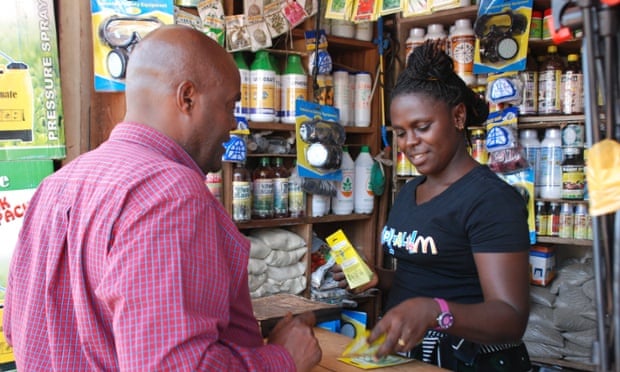












![ethiochina[1]](http://africapotashblog.files.wordpress.com/2013/05/ethiochina1.jpg?w=370&h=216)






























